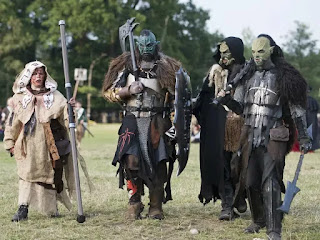LARPING Fun
Larping is the practice of enacting a fictional character or life for one or several days. It was first put forward in 1981 in Norway, where the gaming group Boel built the first well-known elaborate (and fun) larp location, Bree, in the forests of Bergen. It started out as a means to develop a fantasy role-playing game with the intent of participating in its interpretation of the world and literature. Although Boel is no longer active in larping, it is very likely that many of the techniques that made larping what it is today were established here.
Some of the earliest examples of larp were done without much thought in order to learn about the social aspect of role-playing. They are often seen in the form of small role-playing games that consisted of other RPG types. These were often called a “side-kick,” or “background-player.” This style still exists today, but has become much more popular as the social aspects of larp have become more integrated into the gaming world. Another early example was a game called Per Se, which was organized by students of the University of Pennsylvania, which ran in the fall of 1980. This was very much in the vein of playing out the world of Romeo and Juliet in the mountains of West Virginia.
At that point, what we now call “lore management” was beginning to develop. One of the earliest examples of this was seen in the game Druids of Ice, which was organized by Aleister Dunn and Jack Sherman in Minnesota in 1981. This game was basically a description of the shape-shifting druids from the Lovecraft stories, and each year they would write up a new long-term player contract for the society. The purpose of this was to learn about the role-playing game of Druids and who would actually be playing the game as well as the players’ social rules and expectations of conduct and the legal aspects of being a gaming corporation. From this experience, the concept of character “artifice” was created, which means to create a character in a role-playing game which is an outward projection of a player’s own persona.
The first commercially organized larp was the incredibly popular English-speaking Larpcon, which was held in Pittsburgh, PA, in 1986. This was a combined LARP convention and role-playing game convention, where the majority of the attendees were larpers (mainly role players) but also included some larpers who came specifically for the convention. This was the first of what would be some of the more well-known conventions around the world in the coming years. The convention remained in Pittsburgh for about ten years.
One of the primary methods of structuring larp to be more like a social event than a traditional gaming convention is the concept of “circuses.” In a circus, the performers are often in an arena for the majority of their performances, with the set (and sometimes performers) confined to the circular set itself. It is a very free-form style of performance, in which different components are rotated from time to time. The London Wargamers Circus, which has been going for twenty years, follows this model very closely. Although there is a small table in the center, most of the set is empty during performances. The reason for this is that this kind of performance is geared more towards enjoyment of the spectacle than for any kind of competition with the other performers. In this way, larp allows participants to experience the world of a story like a circus performers would.
Another idea which is becoming more widely accepted as the more social style of larp becomes more common is “play as much as possible.” This practice is not necessarily reserved for single play sessions, but can also be done for the duration of an entire convention, and is something which is becoming more and more popular as more and more LARPers attend conventions with groups of friends, or even strangers.
Finally, larping is increasingly being developed with a more game design aspect, especially as time goes by.




Comments
Post a Comment